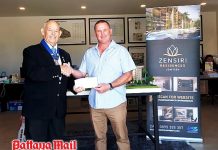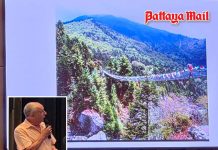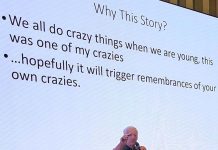Pressure points are the key to self-defence. This was the message at the Sunday, November 1, meeting of the Pattaya City Expats Club. Scott Rohr made his second appearance to talk about and demonstrate martial arts for self-defence. Scott is a 58-year-old expat from Portland, Oregon living in Pattaya. Scott is a highly successful student and practitioner of the arts of karate and taekwondo. He started studying martial arts in 1969 at the age of 12. In 1988 Scott was selected to carry the Olympic torch for one kilometre in Seoul Korea during the pre-games run up.
Scott reviewed the history of martial arts, explaining that they originated in India centuries ago (not China as many people would have thought). Different forms of martial arts were developed in Northern and Southern India as methods of unarmed combat. Martial arts spread to China and Japan where over a hundred authentic fighting systems were developed in the last 800 years and are still being taught. The practitioners of martial arts in places like Okinawa were court dignitaries, military officers, scholars and artisans. This was the genesis of both karate and taekwondo.
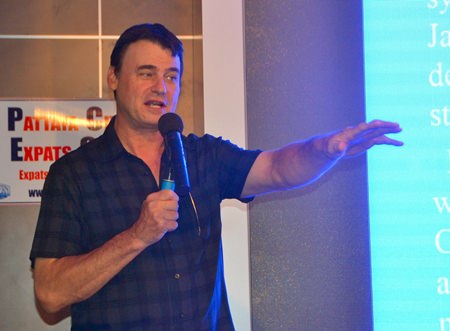 Pattaya resident Scott Rohr, martial arts Grand Master of taekwondo, describes the history of martial arts from its beginnings in India and its spread through China to Okinawa to Japan to his PCEC audience.
Pattaya resident Scott Rohr, martial arts Grand Master of taekwondo, describes the history of martial arts from its beginnings in India and its spread through China to Okinawa to Japan to his PCEC audience.
The iconic forms of karate are known as Kata. Wikipedia states that Kata is a Japanese word describing detailed patterns of movements practiced either solo or in pairs. Each is a complete fighting system, with the movements and postures of the kata being a living reference guide to the correct form and structure of the techniques used within that system. Karate Kata are executed as a specified series of a variety of moves, with stepping and turning, while attempting to maintain perfect form. The practitioner is counseled to visualise the enemy attacks and their responses. Karateka “read” a kata in order to explain the imagined events. The kata is not intended as a literal depiction of a mock fight, but as a display of transition and flow from one posture and movement to another, teaching the student proper form and position, and encouraging them to visualise different scenarios for the use of each motion and technique. There are various forms of kata, each with many minor variations.
Scott explained that after the Second World War, when American troops were stationed in Okinawa, American soldiers learned about Kata from the grandmasters there. However, the grandmasters possessed some secret moves that they did not impart to their American students. After all, the Americans were their occupiers. Further, many of these soldiers opened karate schools when they returned to the U.S. Some of them made pilgrimages back to Okinawa to see their teachers. The teachers were impressed with the progress their students had made and began to reveal some of the secrets they had kept from them.
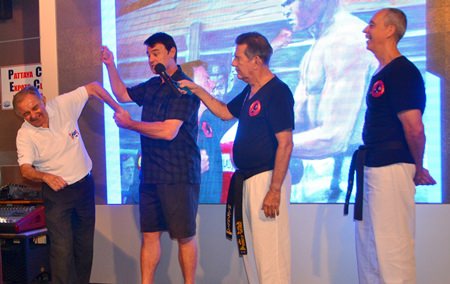 Scott Rohr demonstrates a self-defence move using pressure points to take down an opponent. Club member Lawrie Mcloughlin as the opponent grimaces while Jim Jones and Brian Dowd look on.
Scott Rohr demonstrates a self-defence move using pressure points to take down an opponent. Club member Lawrie Mcloughlin as the opponent grimaces while Jim Jones and Brian Dowd look on.
In 1993, Scott began a student/teacher relationship with Karate Grand Master George Dillman of Reading PA. Dillman opened the door to long hidden neural pressure point knowledge in Kata. These special moves were such a precious commodity that they were never described in writing. Dillman was able to learn these moves from several very old Okinawa grandmasters.
Scott explained that when most people think of karate, they see self-defence moves that involve blocking, punching and kicking. But the secret, more esoteric movements involve learning the correct angle and direction to attack pressure points in the body’s nerves (known as the “neural” or “nervous” system). Attacking these pressure points is very effective, and can cause unconsciousness and even death. He said that this hidden knowledge profoundly changed his understanding of karate. Previously, Scott said, karate felt like carrying a gun with no bullets.
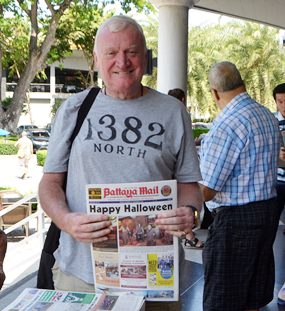 Attendance at the PCEC’s meetings is not only free entry (breakfast recommended, but optional), it also has its reward of a free copy of the Pattaya Mail at the end of every Sunday meeting.
Attendance at the PCEC’s meetings is not only free entry (breakfast recommended, but optional), it also has its reward of a free copy of the Pattaya Mail at the end of every Sunday meeting.
He explained that there are about 700 pressure points on the body, 350 on each side, and that the martial arts use 30 to 40 of these points. The points are where nerves begin or end, and where they split. About 10 of the points are in the arm; two are in the wrist and one is in the hand. Scott showed the audience that there is a pressure point under the wrist that, when pressed, will immediately open up a fist.
With the assistance of two fellow practitioners, Brian Dowd and club member Jim Jones, who has studied martial arts and has a 2nd degree black belt, and with the participation of some members of the audience, Scott explained and demonstrated several situations where pressure points can be used to defend oneself from attack. The moves involved being grabbed by the forearm; being pushed against the wall and grabbed at the neck; dealing with an obnoxious and usually larger person putting his arms around your shoulder and pushing you around that way; and pulling an attacker’s pinkie finger back behind the hand to release a grip.
After the presentation, MC Ren Lexander brought everyone up to date on upcoming events and called on Judith Edmonds to conduct the Open Forum, where questions are asked and answered about Expat living in Thailand, especially Pattaya.
For more information on the PCEC’s many activities, visit their website at www.pcecclub.org.
For video of today’s event, visit https://www.youtube.com/watch?v=xbr-LXkuA5c.


